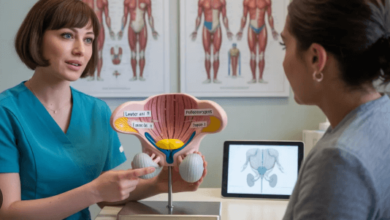tDCS for Chronic Pain: Safety, Efficacy, and Considerations for Clinical Practice

Understanding Chronic Pain and Its Impact
Chronic pain affects millions of people worldwide, leading to persistent discomfort that can interfere with daily activities, relationships, and overall quality of life. Unlike acute pain, which serves as a warning signal for injury or illness, chronic pain persists for months or even years, often without an obvious cause. It can stem from conditions like arthritis, back pain, fibromyalgia, or nerve damage and is often resistant to traditional treatments such as medications and physical therapy.
For those suffering from chronic pain, finding an effective treatment can be a long and frustrating journey. In recent years, tDCS treatment in Australia has emerged as a promising option for managing chronic pain. This non-invasive therapy uses direct electrical currents to stimulate specific areas of the brain, potentially altering pain perception and offering significant relief.
This article will explore the safety, efficacy, and clinical considerations of tDCS for chronic pain, with a focus on its application within chronic pain treatment in Australia.
What is tDCS (Transcranial Direct Current Stimulation)?
Transcranial Direct Current Stimulation (tDCS) is a form of neuromodulation that uses a low electrical current to modulate neuronal activity in the brain. During a tDCS session, two electrodes are placed on the scalp, and a mild, constant electrical current is applied to specific areas of the brain. The current alters the membrane potential of neurons, either increasing or decreasing their activity, depending on the polarity of the electrodes.
tDCS is considered a non-invasive technique, making it appealing for those who wish to avoid more invasive procedures like surgery or the side effects of pharmacological treatments. Research has shown that tDCS can influence various brain regions involved in pain perception, particularly the motor cortex and somatosensory cortex, both of which play significant roles in chronic pain management.
How Does tDCS Work for Chronic Pain Treatment?
The exact mechanisms by which tDCS alleviates chronic pain are not fully understood, but there are several potential explanations:
- Modulation of Pain Pathways: tDCS can alter the excitability of neurons in pain-related regions of the brain, such as the motor cortex. By influencing these pathways, tDCS may reduce the brain’s sensitivity to pain signals, effectively decreasing the perception of pain.
- Increase in Endorphin Release: The electrical stimulation from tDCS may increase the release of endorphins—natural pain-relieving chemicals produced by the body—which can help modulate pain levels and improve mood.
- Neuroplasticity: tDCS may promote changes in the brain’s wiring, or neuroplasticity, which could help improve the brain’s ability to regulate pain over time. This is particularly important for individuals with chronic pain, as their brain circuits may have become “hardwired” to perceive pain, and tDCS may help rewire these circuits.
The Efficacy of tDCS for Chronic Pain Treatment in Australia
tDCS has been investigated for its efficacy in treating various forms of chronic pain, including neuropathic pain, fibromyalgia, and musculoskeletal pain. The results of research studies have been promising, with many showing significant reductions in pain intensity and improvements in quality of life for patients undergoing tDCS treatment.
Several clinical trials have demonstrated that tDCS can be effective in reducing pain in conditions such as:
- Neuropathic Pain: tDCS has been shown to reduce neuropathic pain, which is caused by damage to the nerves. This type of pain is often difficult to treat, but studies indicate that tDCS can help alleviate symptoms in patients with conditions like diabetic neuropathy or post-surgical neuropathic pain.
- Fibromyalgia: Fibromyalgia is a condition characterised by widespread musculoskeletal pain, often accompanied by fatigue and sleep disturbances. Research has shown that tDCS can reduce pain in fibromyalgia patients by modulating brain regions involved in pain processing.
- Musculoskeletal Pain: Chronic musculoskeletal pain, such as back pain or joint pain, can also benefit from tDCS therapy. Studies have found that tDCS can decrease pain and improve function in patients with chronic musculoskeletal conditions.
However, it’s important to note that while the efficacy of tDCS for chronic pain is supported by numerous studies, not all patients experience the same level of benefit. Some individuals may have a more significant reduction in pain than others, and the effects of tDCS may vary depending on factors such as the type of chronic pain, the area of the brain targeted, and the duration of treatment.
Safety of tDCS Treatment in Australia
One of the major benefits of tDCS is its safety profile. tDCS is considered a low-risk treatment, with few side effects. When administered correctly, tDCS is generally well-tolerated by patients. The most common side effects reported during tDCS sessions include:
- Mild Tingling or Itching: Patients may experience a mild tingling sensation at the site of the electrodes during the treatment, which is usually temporary and fades shortly after the session ends.
- Headache: Some patients may experience mild headaches, although this is not common and typically resolves quickly.
- Skin Irritation: The electrodes may cause mild skin irritation or redness at the contact site, but this is also short-lived and resolves after the session.
tDCS is non-invasive, meaning there are no incisions, injections, or general anaesthesia involved, further reducing the risk of complications. Furthermore, tDCS does not require the use of medication, so there is no risk of drug-related side effects or dependency.
However, tDCS should only be administered by trained professionals who understand the correct protocols for treatment. It is important that patients seeking tDCS treatment in Australia undergo a thorough assessment to ensure the therapy is appropriate for their specific condition.
Clinical Considerations for tDCS in Chronic Pain Treatment
Before embarking on tDCS as a treatment for chronic pain, several factors should be considered:
- Patient Selection: tDCS is not suitable for everyone. Individuals with certain medical conditions, such as epilepsy or a history of seizures, may not be appropriate candidates for tDCS. A thorough evaluation by a healthcare provider is essential to ensure the therapy is safe for each patient.
- Treatment Protocol: The duration and frequency of tDCS sessions can vary depending on the individual’s pain condition and treatment goals. Generally, a typical tDCS treatment schedule involves daily sessions for several weeks, followed by a tapering phase. The specific area of the brain targeted during treatment can also influence the effectiveness of tDCS, so a tailored approach is necessary.
- Combination with Other Therapies: tDCS is often used in combination with other chronic pain treatments, such as physical therapy, cognitive behavioural therapy (CBT), or pharmacological interventions. A multidisciplinary approach can enhance the overall effectiveness of treatment and improve outcomes for patients.
Future of tDCS for Chronic Pain Treatment in Australia
The use of tDCS treatment in Australia for chronic pain is an exciting area of research. As more studies are conducted, the treatment protocols may become more refined, and tDCS could become a mainstream option for managing chronic pain. The potential for tDCS to complement other treatments offers hope to those with chronic pain who have not responded well to traditional therapies.
Conclusion
tDCS represents a promising option for the treatment of chronic pain, offering a non-invasive, safe, and potentially effective alternative to more traditional pain management methods. While research is still ongoing, early findings suggest that tDCS treatment in Australia can provide significant relief for those suffering from conditions such as neuropathic pain, fibromyalgia, and musculoskeletal pain. As always, it is essential for patients to consult with healthcare professionals to determine if tDCS is the right treatment for their specific needs.
If you are exploring chronic pain treatment in Australia, tDCS could be a valuable addition to your pain management plan. As part of a holistic approach, it may offer relief and improve your quality of life.





